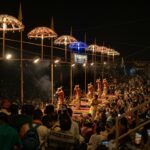Ranthambore national Park is located in Rajasthan, biggest state of India. Its name comes from the vast fort that stand in the middle of forest. In fact, there is endless speculation regarding the founding of the fort. Many historians have believed that it built by Chuhan dynasty in 944AD. The fort has an area of 4.5 sq.km. The area around it is ruins, lakes palaces, ancient step-wells, cupolas. guard-posts, temples and memorial stones.
The indigenous residents of Ranthambore forest people were called the Meenas. Before arrival of British, the Meena’s were lived freely and easily in the forest. By the turn of century, the Ranthambore forest had become hunting reserve of Maharaja of Jaipur. Hunting ended in 1970, when less than 2000 tigers remained of the 19th century papulation of up to 50000.
This park has interesting history. Pre-independence the area of park was hunting reserve of Maharaja of Jaipur till it declared a sanctuary. In 1955 it declared as Swai Madhopur Wildlife sanctuary. In 1973 Tiger project was started to protect tigers. This park has got extra financial resources from government of India to facilitate better management. The National Park still has an area of 300sq. km., where all human activities are prohibited. This is where you spend time to spot tigers and wildlife.
Tiger appearance and habits.
Bengal Tiger weight around 65-300 Kg depending on subspecies and sex. Lenth 2-3.3 meter. Life spam 15-18 years. Gestation period 98-108 days. Litter size 1-4 cubs.
Though slim and elegant, tigers are immensely powerful. Their front legs and paw are tremendously strong. They can kill young elephant and rhino. Tiger can kill prey that own weight. A tiger can eat over 30 kg of meat in a single night. Tigers tent to hunt between dusk and down. They are less active during the day. Tigers’ cubs are born blind and helpless, weighing only 1.5kg. The cub’s eyes open after one or two weeks.
Male tiger leaves their mother at about 18-20 months old. Each young male must then look for a vacant territory. Females remain with their mothers 24-28 months. One daughter may be allowed to settle inside the mother’s territory, but rest must find their own territory.
How to search Tiger.
In general wild animals are shy and elusive.
>Track pugmark provides important clues. Not only they tell us presence of wild animal but they also provide us information about size, sex and even sometime age of animal.
>Look out for scratch marks on trees where tigers leave territorial signals that demarcate their home range. These trees are also marked by their scent.
>Alarm and scare calls of animals like sambar, chital, blue bull, chinkara, langur, monkeys, or even peacock provide you clue the exact location of the tigers.
>Always pause, listen and assess the clue that the forest provides about.
How to reach there.
- From Delhi we have direct train to Ranthambore. Road connectivity has been improved. One can go by Bus also. It is around 5-6 hrs drive.
- Nearest airport is Jaipur. It is around 3 hrs drive from Ranthambore.
- Connectivity by train from almost all major cities.
| Monthly Safari Booking | Timing Options |
| From 1st Oct to 31st Oct: | 06:30 am – 10:00 am & 02:30 pm – 06:00 pm |
| From 1st Nov to 31st Jan: | 07:00 am – 10:30 am & 02:00 pm – 05:30 pm |
| From 1st Feb to 31st Mar: | 06:30 am – 10:00 am & 02:30 pm – 06:00 pm |
| 06:30 am – 10:00 am & 02:30 pm – 06:00 pm | 06:00 am – 09:30 am & 03:00 pm – 06:30 pm |
| From 16th May to 30th June: | 06:00 am – 09:30 am & 03:30 pm – 07:00 pm |
Key Info to Check Before Ranthambore Tiger Safari
>The Ranthambore National Park is distributed into 10 safari zone.
>You will get a zone based on availability.
>The amount will be refunded if your Ranthambore National Park safari booking is not confirmed.
>The full amount will be returned to your bank account in case of technical issues or zone unavailability.
>The Jeep Safari and Canter Safari amount is not refundable after booking confirmation.











